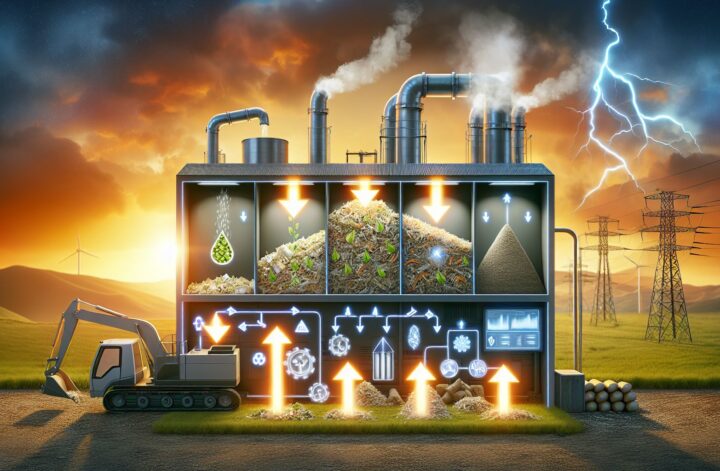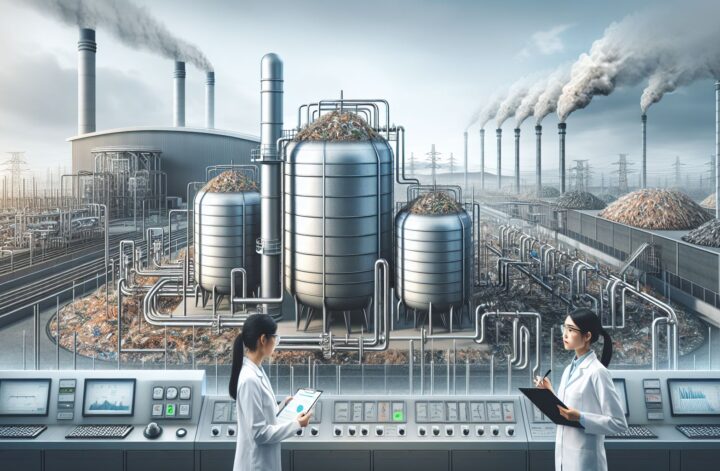Understanding the potential of biological processes to convert waste to useful energy resources is a stepping stone to harnessing renewable energy sources. Anaerobic digestion, particularly high-rate anaerobic digestion, is a standout technology in the realm of bioenergy technology. As we move towards sustainable cities and communities, it is becoming increasingly important to comprehend the intricacies of high-rate anaerobic digestion.
What is High-Rate Anaerobic Digestion?
High-rate anaerobic digestion is a form of waste treatment that breaks down organic matter in the absence of oxygen, yielding valuable byproducts such as biogas and digestate. Any organic waste, categorized as bio-degradable, can be processed under thumb of anaerobic digestion, although the efficiency, speed, and outcome solely depend on the type of the digester^.^1^
High-rate anaerobic digestion is characterized by the ability to treat high organic loading rates swiftly, hence the term ‘high-rate.’ The technology stands out for its potential to treat high volumes of waste within a significantly reduced hydraulic and solid retention time.
The Process of High-Rate Anaerobic Digestion
High-rate anaerobic digestion encapsulates series of biological reactions, namely hydrolysis, acidogenesis, acetogenesis, and methanogenesis.^2^
Hydrolysis – The process beings with breaking down complex organic compounds into simpler ones.
Acidogenesis – Version of the anaerobic digestion where the hydrolyzed products are then fermented into volatile fatty acids, and other simpler compounds.
Acetogenesis – The next stage involves conversion of the fermented compounds into acetic acid, hydrogen, and carbon dioxide by acetogenic bacteria.
Methanogenesis – The final stage is to convert the acetic acid, hydrogen and carbon dioxide into methane gas by methanogenic bacteria.
These four steps, happening in harmony, allow the digester to handle high volumes of waste effectively and efficiently, resulting in a quicker turnover time.
The Potential of High-Rate Anaerobic Digestion
High-rate AD has scored its rightful place in the the green energy industry by virtue of the valuable products it offers.
1. Biogas production: The production of methane-rich biogas is one of the most salient features of high-rate anaerobic digestion. Biogas, as a renewable source of energy, it is gaining popularity for use in heating, electricity, and food production, among others.^3^
2. Digestate: The residual solid-liquid matter derived from the process, known as digestate, is rich in nutrients. Consequently, it finds use in agriculture as a soil conditioner, contributing significantly to sustainable farming practices.
3. Biosolids Treatment: It also plays a critical role in the stabilization of sludge from wastewater treatments, creating environmentally-friendly biosolids that can be reused.
4. Role in Methane Capture: High-rate anaerobic digestion also contributes to the containment of methane gas, a potent greenhouse gas responsible for global warming. In essence, it supports the reduction of greenhouse gas emission, making it a fitting candidate for climate change mitigation.
The Future of High-Rate Anaerobic Digestion
High-rate anaerobic digestion’s beauty lies in its prowess to rather turn waste into valuable output. However, there is still a scope of improvement for more efficiency and higher yields.
Addressing the challenges such as, ammonia toxicity, sulfide toxicity, and inhibition of anaerobic digestion by employing bioaugmentation or adding trace elements diet to the digester, can further ameliorate the digestion process and can contribute towards an efficient, sustainable future waste management.
High-rate anaerobic digestion is indeed an asset in the backdrop of today’s bioenergy landscape. Climbing the ladders of sustainability requires a fundamental understanding and love for technologies like these, which are not just creatively brilliant but also, are instrumental in shifting towards a cleaner and greener world.
Sources
- Deublein, D., & Steinhauser, A. (2008). Biogas from waste and renewable resources: an introduction. Wiley-VCH.
- Liu, D. (2013). Methanogenic archaea: key organisms in anaerobic digestion processes. Anaerobic Digestion Processes: Applications and Efficiencies. Nova Science Publishers.
- Rivard, C. J., & Smith, G. B. (1997). Biohydrogen and methane production via a two-step anaerobic digestion process. Bioresource technology, 59(1), 63-68.
[^1^]: Biogas from waste and renewable resources: an introduction
[^2^]: Methanogenic archaea: key organisms in anaerobic digestion processes
[^3^]: Biohydrogen and methane production via a two-step anaerobic digestion process




